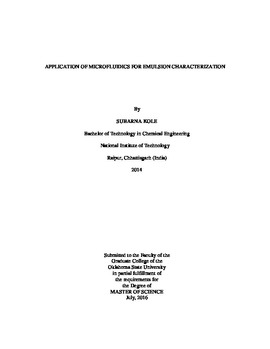| dc.contributor.advisor | Bikkina, Prem Kumar | |
| dc.contributor.author | Kole, Subarna | |
| dc.date.accessioned | 2017-02-22T22:15:24Z | |
| dc.date.available | 2017-02-22T22:15:24Z | |
| dc.date.issued | 2016-07-01 | |
| dc.identifier.uri | https://hdl.handle.net/11244/49099 | |
| dc.description.abstract | The formation of emulsions is an inevitable process during crude oil production and refining. This is because of the complex multiphase flow resulting in the mixing of oil and water and formation of stable emulsions. The resulting emulsion must be separated into its constituent oil and water phases before any further downstream processing. In order to separate the emulsions efficiently, the factors affecting its formation and stability must be properly understood. Droplet size is one of the critical factors that influence stability of an emulsion. This thesis focuses on the application of a custom designed microfluidics facility for emulsion formation and stability analysis. The experimental facility has a unique capability to produce controlled mono-dispersed oil-in-water (O/W) and water-in-oil (W/O) emulsions using hydrophobic and hydrophilic X-junction microfluidic chips, respectively. Water/aqueous salt solutions/aqueous surfactant solutions were used as aqueous phase fluids and n-decane/n-hexadecane/oil soluble surfactant solutions were used as organic phase fluid. The experimental results indicating the effects of organic phase, aqueous phase salinity, salt type, total flowrate, water-cut and surfactant type and concentration on the droplet size are presented. Stability experiments have been carried out to observe droplet coalescence phenomena and the temporal evolution of the drop size. NaCl, KCl and CaCl2 salts were used to study the effect of salt type and concentration on the droplet size during the formation of O/W and W/O emulsions. The type and concentration of the inorganic salts studied have a negligible effect on the droplet size of both O/W and W/O type emulsions. However, for a given set of external phase and droplet phase velocities, oil droplet size is observed to be considerably larger than the aqueous phase droplets. Oil soluble (Span 80) and water soluble (SDS) surfactants caused a significant reduction in droplet sizes for both O/W and W/O emulsions compared to their respective base case (without surfactant) droplet sizes. Water-cut and oil fraction had no effect on the size of water and oil droplets respectively. On the other hand, an increase in the continuous phase flow rate caused a decrease in the droplet diameter for both O/W and W/O emulsions. Effect of organic phase was also studied by comparing the size of n-decane and n-hexadecane droplets in O/W emulsion. N-Decane formed smaller droplets under similar flow rate conditions. It was also observed that the formation of droplets does not necessarily guarantee the stability of emulsions as there can be rapid droplet coalescence in some cases, especially when there is no or low amount of surfactant. | |
| dc.format | application/pdf | |
| dc.language | en_US | |
| dc.rights | Copyright is held by the author who has granted the Oklahoma State University Library the non-exclusive right to share this material in its institutional repository. Contact Digital Library Services at lib-dls@okstate.edu or 405-744-9161 for the permission policy on the use, reproduction or distribution of this material. | |
| dc.title | Application of Microfluidics for Emulsion Characterization | |
| dc.contributor.committeeMember | Madihally, Sundar | |
| dc.contributor.committeeMember | Hareland, Geir | |
| osu.filename | Kole_okstate_0664M_14819.pdf | |
| osu.accesstype | Open Access | |
| dc.description.department | Chemical Engineering | |
| dc.type.genre | Thesis | |
| dc.type.material | text | |
